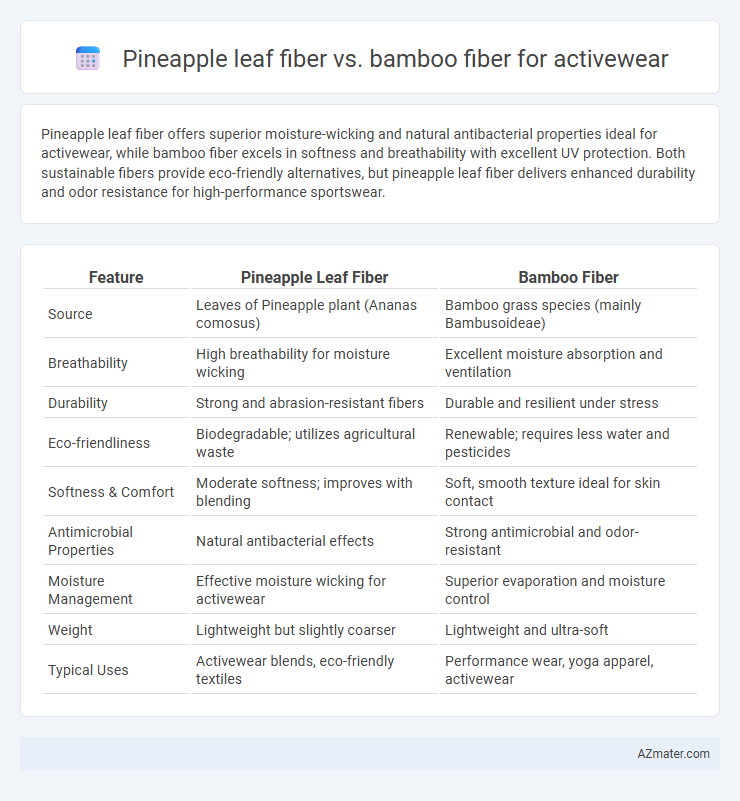Pineapple leaf fiber offers superior moisture-wicking and natural antibacterial properties ideal for activewear, while bamboo fiber excels in softness and breathability with excellent UV protection. Both sustainable fibers provide eco-friendly alternatives, but pineapple leaf fiber delivers enhanced durability and odor resistance for high-performance sportswear.
Table of Comparison
| Feature | Pineapple Leaf Fiber | Bamboo Fiber |
|---|---|---|
| Source | Leaves of Pineapple plant (Ananas comosus) | Bamboo grass species (mainly Bambusoideae) |
| Breathability | High breathability for moisture wicking | Excellent moisture absorption and ventilation |
| Durability | Strong and abrasion-resistant fibers | Durable and resilient under stress |
| Eco-friendliness | Biodegradable; utilizes agricultural waste | Renewable; requires less water and pesticides |
| Softness & Comfort | Moderate softness; improves with blending | Soft, smooth texture ideal for skin contact |
| Antimicrobial Properties | Natural antibacterial effects | Strong antimicrobial and odor-resistant |
| Moisture Management | Effective moisture wicking for activewear | Superior evaporation and moisture control |
| Weight | Lightweight but slightly coarser | Lightweight and ultra-soft |
| Typical Uses | Activewear blends, eco-friendly textiles | Performance wear, yoga apparel, activewear |
Introduction to Pineapple Leaf Fiber and Bamboo Fiber
Pineapple leaf fiber, derived from the leaves of the Ananas comosus plant, offers a natural, eco-friendly alternative known for its durability and breathability in activewear. Bamboo fiber, extracted from the bamboo plant, is celebrated for its moisture-wicking properties, antibacterial benefits, and softness, making it ideal for performance garments. Both fibers contribute sustainable options for activewear production while enhancing comfort and functionality.
Sustainable Sourcing: Comparing Eco-Friendliness
Pineapple leaf fiber offers exceptional sustainability due to its utilization of agricultural waste, reducing deforestation and minimizing water consumption compared to traditional fibers. Bamboo fiber, while renewable and fast-growing, requires energy-intensive processing and sometimes chemical treatments, which can impact its eco-friendliness. Choosing pineapple leaf fiber over bamboo fiber for activewear supports more sustainable sourcing by leveraging a byproduct that promotes waste reduction and lower environmental impact.
Fiber Extraction and Processing Methods
Pineapple leaf fiber is extracted through a decortication process that separates long, coarse fibers from the leaves, requiring retting and mechanical scraping to produce a strong, breathable textile ideal for activewear. Bamboo fiber extraction involves either mechanical crushing and retting or chemical processing to break down the bamboo pulp into soft, durable fibers with excellent moisture-wicking properties. Both fibers are eco-friendly alternatives, but pineapple leaf fibers offer higher tensile strength, while bamboo fibers provide smoother texture and natural antibacterial benefits, making their processing methods crucial in defining performance characteristics for activewear.
Comfort and Breathability in Activewear
Pineapple leaf fiber offers excellent breathability and moisture-wicking properties, making it ideal for activewear designed to keep the body cool and dry during intense workouts. Bamboo fiber excels in softness and natural antibacterial qualities, enhancing comfort by reducing odor and skin irritation in prolonged wear. Both fibers provide sustainable alternatives, but pineapple leaf fiber tends to be more durable, while bamboo fiber delivers superior lightweight comfort.
Moisture-Wicking and Quick-Dry Capabilities
Pineapple leaf fiber exhibits excellent moisture-wicking properties due to its natural porous structure, efficiently drawing sweat away from the skin and enhancing comfort during activewear use. Bamboo fiber also provides strong moisture-wicking capabilities, complemented by its antimicrobial properties that reduce odor and improve freshness. Both fibers offer quick-dry performance, but bamboo fiber typically dries faster due to its fine, hollow micro-gaps that facilitate rapid evaporation.
Durability and Longevity of Fabrics
Pineapple leaf fiber offers exceptional durability due to its tough lignin-rich structure, making it highly resistant to wear and tear in activewear applications. Bamboo fiber, while soft and moisture-wicking, tends to degrade faster under frequent washing and high-intensity use. Activewear crafted from pineapple leaf fiber typically exhibits superior longevity, maintaining fabric strength and shape over extended periods compared to bamboo fiber alternatives.
Biodegradability and Environmental Impact
Pineapple leaf fiber and bamboo fiber both offer biodegradable alternatives for activewear, with pineapple leaf fiber decomposing faster due to its natural lignin and cellulose structure, reducing long-term waste. Bamboo fiber, while renewable, undergoes chemical processing that can affect its biodegradability and increase environmental impact if not managed sustainably. Choosing pineapple leaf fiber supports lower ecological footprints through its agricultural byproduct use, minimizing resource consumption and soil degradation compared to conventional bamboo harvesting methods.
Allergenicity and Skin-Friendliness
Pineapple leaf fiber is naturally hypoallergenic and breathable, making it ideal for activewear designed for sensitive skin, while bamboo fiber also offers excellent moisture-wicking properties but may cause irritation in individuals prone to allergies due to its processing chemicals. Both fibers provide antibacterial benefits that reduce odor, but pineapple leaf fiber's minimal chemical treatment enhances its skin-friendliness compared to bamboo. Choosing pineapple leaf fiber ensures reduced allergenicity, promoting comfort and protection during intense physical activities.
Price Comparison and Market Availability
Pineapple leaf fiber is generally more expensive than bamboo fiber due to its limited production scale and labor-intensive extraction process, whereas bamboo fiber benefits from larger-scale cultivation and more automated manufacturing, leading to lower costs. Bamboo fiber is widely available in the activewear market, supported by established supply chains and greater consumer awareness, while pineapple leaf fiber remains niche with limited availability mostly in eco-conscious and luxury segments. Price differences reflect not only raw material costs but also market demand, with bamboo dominating due to affordability and accessibility.
Future Trends in Eco-Friendly Activewear Materials
Pineapple leaf fiber and bamboo fiber are emerging as sustainable alternatives in eco-friendly activewear, with pineapple leaf fiber offering high tensile strength and natural moisture-wicking properties ideal for performance wear. Bamboo fiber, known for its breathability, antibacterial qualities, and biodegradability, continues to gain traction in the sustainable apparel market, driven by increasing consumer demand for renewable resources. Future trends indicate a significant rise in hybrid blends combining pineapple leaf and bamboo fibers to enhance durability, comfort, and environmental impact, aligning with the industry's shift towards zero-waste and circular economy principles.

Infographic: Pineapple leaf fiber vs Bamboo fiber for Activewear
 azmater.com
azmater.com